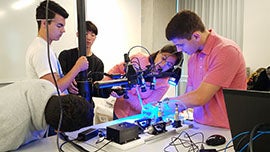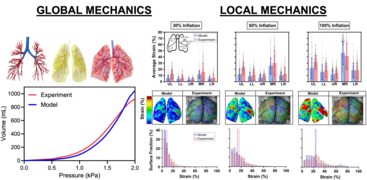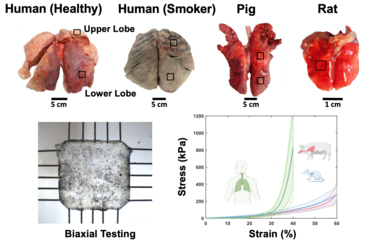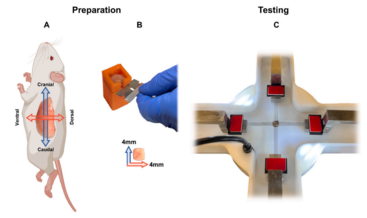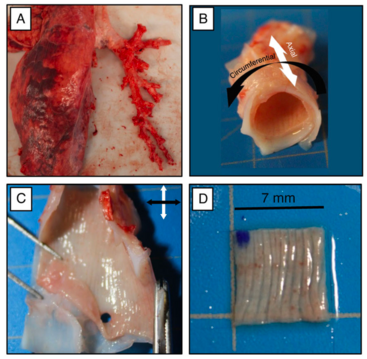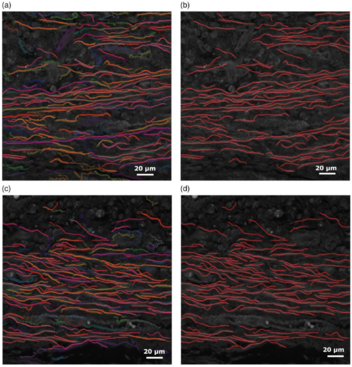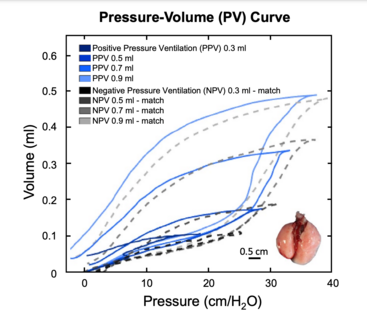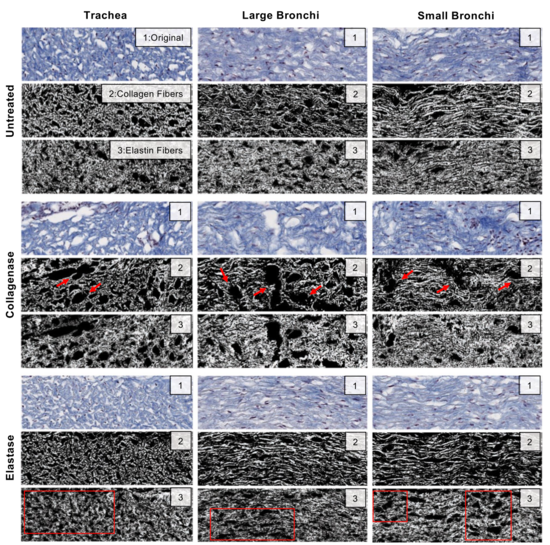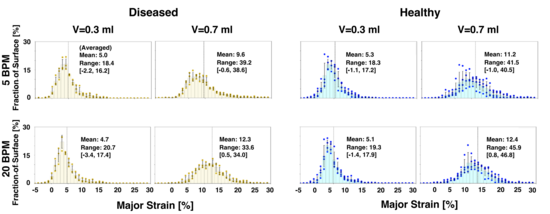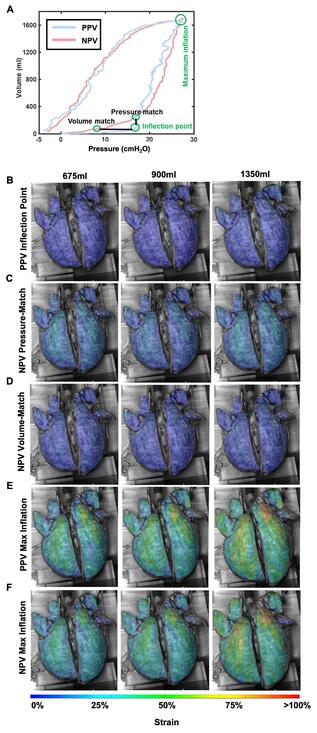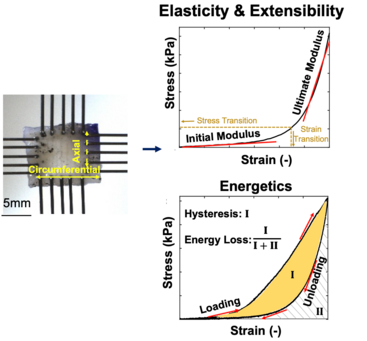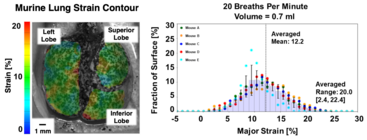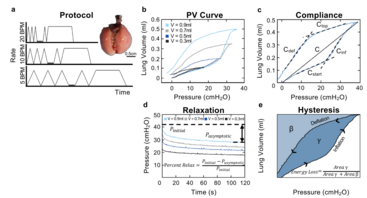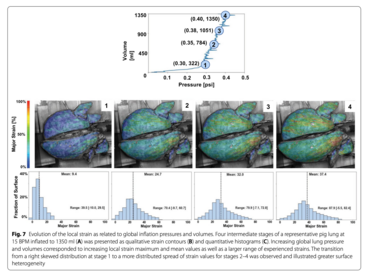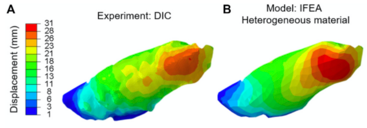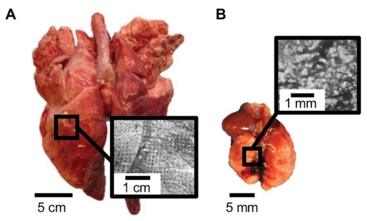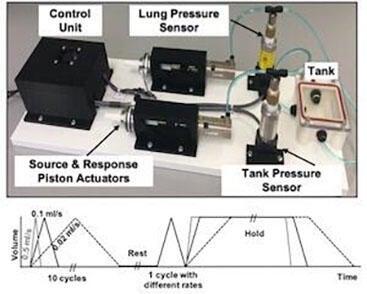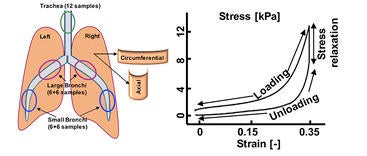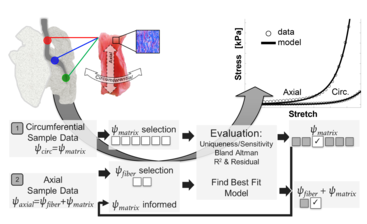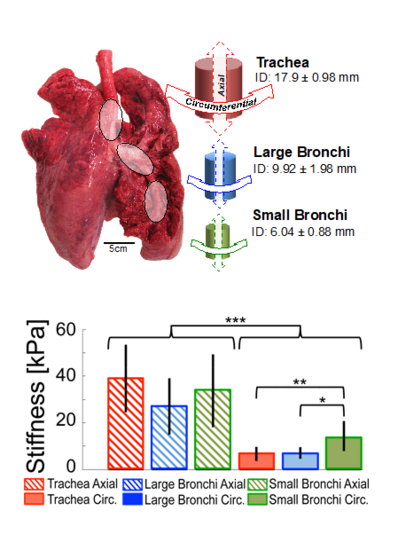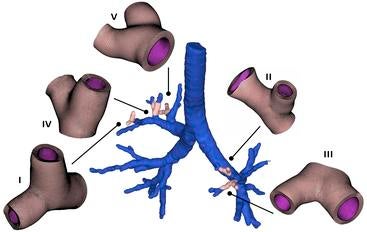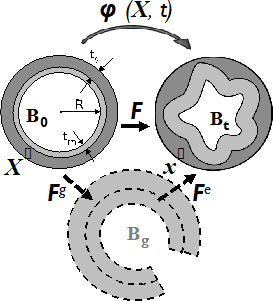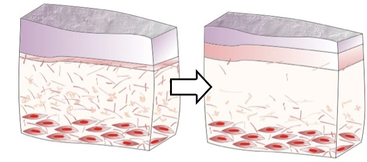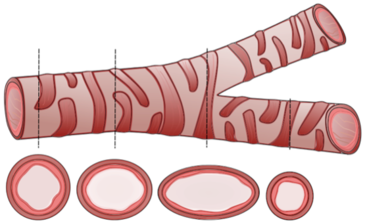Research
We aim to advance the state of pulmonary healthcare through investigation of fundamental lung biomechanics. By utilizing Theory, Simulation, and Experiments to understand how tissue structure governs function, the bMECH lab ultimately strives to enable clinical translation through predictive modeling, surgical optimization, and medical diagnostics.
Interests:
- Multi-scale computational and experimental approaches integrating organ-tissue-microstructure mechanics
- Associative breathing forces and lung tissue deformation characterization
- Comparative bronchial network stress distribution states of healthy, asthmatic, bronchitis, and cystic fibrosis lungs
- Image-based airway geometry to construct lung motion during breathing cycle
- Fluid-structure interaction models informed by tissue properties geared towards optimizing ventilation pressures
- Surgical planning of lung ablation based on pre-and post pulmonary pressure-volume function analysis
Digital image correlation of whole lung mechanics.
The First Structural Breathing Lung Computational Model
Respiratory diseases represent a significant healthcare burden, as evidenced by the devastating impact of COVID-19. Biophysical models offer the possibility to anticipate system behavior and provide insights into physiological functions, advancements which are comparatively and notably nascent when it comes to pulmonary mechanics research. In this context, an Inverse Finite Element Analysis (IFEA) pipeline is developed to construct the first continuously ventilated three-dimensional structurally representative pulmonary model informed by both organ- and tissue-level breathing experiments from a cadaveric human lung. Here we construct a generalizable computational framework directly validated by pressure, volume, and strain measurements using a novel inflating apparatus interfaced with adapted, lung-specific, digital image correlation techniques. The parenchyma, pleura, and airways are represented with a poroelastic formulation to simulate pressure flows within the lung lobes, calibrating the model’s material properties with the global pressure-volume response and local tissue deformations strains. This advancement marks a significant step towards creating a generalizable human lung model for broad applications across animal models, such as porcine, mouse, and rat lungs to reproduce pathological states and improve performance investigations regarding medical therapeutics and intervention.
Visceral Pleura Mechanics to Design Improved Biomimetic Adhesives
Pulmonary air leaks are amongst the most common complications in lung surgery. Lung sealants are applied to the organ surface and need to synchronously stretch with the visceral pleura, the layer of tissue which encompasses the lung parenchymal tissue. These adhesives are commonly tested on two animals, pig and rat lungs, but applied to human lungs. However, the unknown mechanics of human lung visceral pleura undermines the clinical translatability of such animal-tested sealants and the absence of how pig and rat lung visceral pleura compare to human tissues is necessary to address. Here we quantify the biaxial planar tensile mechanics of visceral pleura from healthy transplant-eligible and smoker human lungs for the first time, and further compare the material behaviors to pig and rat lung visceral pleura. We find that pig visceral pleura exhibits similar initial stiffness moduli and regional trends compared to human visceral pleura, suggesting pig tissue may serve as a viable animal model candidate for lung sealant testing. The outcomes and mechanical characterization of these scarce tissues enables future development of biomimetic lung sealants for improved surgical applications.
Fibrosis and Emphysema Mouse Lung Mechanics
The mechanics of the lung, consisting of high deformation, non-linear, rapid and cyclic loading, remain a critical unknown, hindering advancements in the field despite the pressing urgency of incurable and often fatal pulmonary diseases; such multi-scale ailments impair organ mechanical function by inducing tissue-level alterations. The tensile mechanics of healthy and diseased murine lung parenchyma with induced variable fibrosis and emphysema are compared—exploring multi-rate and directional tissue elasticity and energetics. Remarkably, parenchymal tissue is found to be notably elastic and non-hysteresis prone. Additionally, chronic fibrosis-induced tissues reveal significantly reduced compliance compared to age-matched controls, indicating characteristic stiffening; moreover, maximum stress tends to be greater in exposed than controls. Emphysematous tissues tend to show lower maximum stress than controls, reflective of hallmark tissue destruction and softening. Furthermore, faster loading rate is found to generally yield elevated stiffness and maximum stress, significantly for fibrosis group exposed tissue—this interdependence between loading rate and tissue disease is notable considering the dynamics of breathing. Generally, control tissues are found to be isotropic, as are emphysematous tissues, but fibrosis may lead to increased anisotropy. Additionally, fibrotic and mature-healthy lungs are found to show age effect trends, such as increased strain energy.
Invited Issue on Lung Tissue Characterization: Sharing Critical Experimental and Computational Techniques for Pulmonary Biomechanics Researchers
The lung is comprised of multiple components including the parenchyma, airways, and visceral pleura, where each constituent displays specific material properties which, together, govern the whole organ’s properties. The structural and mechanical complexity of the lung has historically undermined its comprehensive characterization, especially compared to other biological organs, such as the heart or bones. Establishing the mechanical properties of the lung is central to formulating a baseline understanding of its operation, which can facilitate investigations of diseased states and how the lung will potentially respond to clinical interventions. Here we present established and widely accepted experimental protocols for pulmonary material quantification, specifying how to extract, prepare, and test each type of lung constituent under planar biaxial tensile loading in order to investigate the mechanical properties, such as physiological stress-strain profiles, anisotropy, and viscoelasticity. These methods are presented across an array of commonly studied species (murine, rat, and porcine).
Microstructural Mechanics and an Automatic Algorithm for Fiber Characterization
Knowledge of soft tissue fiber structure is necessary for accurate characterization and modeling of their mechanical response. Fiber configuration and structure informs both our understanding of healthy tissue physiology and of pathological processes resulting from diseased states. This study develops an automatic algorithm to simultaneously estimate fiber global orientation, abundance, and waviness in an investigated image. To our best knowledge, this is the first validated algorithm which can reliably separate fiber waviness from its global orientation for considerably wavy fibers.
Positive and Negative Pressure Ventilation Mechanics Depend on the Animal Lung Model
Increased ventilator use during the COVID-19 pandemic resurrected persistent questions regarding mechanical ventilation including the difference between physiological and artificial breathing induced by ventilators (i.e., positive- versus negative-pressure ventilation, PPV vs NPV). To address this controversy, we compare murine specimens subjected to PPV and NPV in ex vivo quasi-static loading and quantify pulmonary mechanics via measures of quasi-static and dynamic compliances, transpulmonary pressure, and energetics when varying inflation frequency and volume. Results indicate that past contradictory findings regarding ventilation mode comparisons in the field may be linked to the chosen animal model. Understanding the differing fundamental mechanics between PPV and NPV may provide insights for improving ventilation strategies and design to prevent associated lung injuries.
The Effects of Tissue Degradation on the Mechanics of the Airways
Common respiratory illnesses, such as emphysema and chronic obstructive pulmonary disease, are characterized by connective tissue damage and remodeling. Two major fibers govern the mechanics of airway tissue: elastin enables stretch and permits airway recoil, while collagen prevents overextension with stiffer properties. Collagenase and elastase degradation treatments are common avenues for contrasting the role of collagen and elastin in healthy and diseased states; while previous lung studies of collagen and elastin have analyzed parenchymal strips in animal and human specimens, none have focused on the airways to date.
Enzymatic treatment demonstrated an increase in airway tissue compliance throughout loading and resulted in at least a 50% decrease in maximum stress overall. Strain transition values led to significant anisotropic manifestation post-treatment, where circumferential tissues transitioned at higher strains compared to axial counterparts. Hysteresis values and energy loss decreased after enzymatic treatment, where hysteresis reduced by almost half of the untreated value. Anisotropic ratios exhibited axially led stiffness at low strains which transitioned to circumferentially led stiffness when subjected to higher strains. Viscoelastic stress relaxation was found to be greater in the circumferential direction for bronchial airway regions compared to axial counterparts.
Evaluating the Mechanics of Diseased Lungs using Local Tissue and Digital Image Correlation
Mechanical ventilation is amongst the few pulmonary interventions to aid respiration, but can be harmful or fatal, inducing excessive regional (i.e., local) lung strains. Previous studies have advanced understanding of diseased global-level lung response under ventilation, but do not adequately capture the critical local-level response. Here, we pair a custom-designed pressure–volume ventilator with new applications of digital image correlation, to directly assess regional strains in the fibrosis-induced ex-vivo mouse lung, analyzed via regions of interest. We discuss differences between diseased and healthy lung mechanics, such as distensibility, heterogeneity, anisotropy, alveolar recruitment, and rate dependencies. Notably, we compare local and global compliance between diseased and healthy states by assessing the evolution of pressure-strain and pressure–volume curves resulting from various ventilation volumes and rates. We find fibrotic lungs are less-distensible, with altered recruitment behaviors and regional strains, and exhibit disparate behaviors between local and global compliance. Moreover, these diseased characteristics show volume-dependence and rate trends. Ultimately, we demonstrate how fibrotic lungs may be particularly susceptible to damage when contrasted to the strain patterns of healthy counterparts, helping to advance understanding of how ventilator induced lung injury develops.
Investigating Artificial versus Physiological Breathing Ventilation Mechanics with Implications for the COVID-19 Pandemic
There is continued debate regarding the equivalency of artificial ventilation (positive pressure ventilation; PPV) and physiological breathing (negative pressure ventilation; NPV). Resolving this question is important because of the different practical ramifications of the two paradigms. We sought to investigate the parallel between PPV and NPV and determine whether or not these two paradigms cause identical ventilation profiles by analyzing the local strain mechanics when the global tidal volume and inflation pressure was matched. A custom-designed electromechanical apparatus was utilized to impose equal global loads and displacements on the same ex-vivo healthy porcine lung using PPV and NPV. High-speed high-resolution cameras recorded local lung surface deformations and strains in real-time and differences between PPV and NPV global energetics, viscoelasticity, as well as local tissue distortion were assessed. During initial inflation, NPV exhibited significantly more bulk pressure-volume compliance than PPV, suggestive of earlier lung recruitment. NPV settings also showed reduced relaxation, hysteresis, and energy loss compared to PPV. Local strain trends were also decreased in NPV, with reduced tissue distortion trends compared to PPV as revealed through analysis of tissue anisotropy. Apparently contradictory previous studies are not mutually exclusive. Equivalent changes in transpulmonary pressures in PPV and NPV lead to the same changes in lung volume and pressures, yet local tissue strains differ between PPV and NPV. While limited to healthy specimens and ex-vivo experiments in the absence of a chest cavity, these results may explain previous reports of better oxygenation and less lung injury in NPV.
Multi-directional Loading Characterization of Airway Tissue, Considering Elasticity, Extensibility, and Energetic Mechanics
The lack of bronchial experiments restricts current airway models to either assume rigid structures, or extrapolate the material properties of the trachea to represent the small airways. Furthermore, past works are exclusively limited to uniaxial testing; investigating the multidirectional tensile loads of both the proximal and distal pulmonary airways is long overdue. Here we present comprehensive mechanical and viscoelastic properties of the porcine airway tree, including the trachea, trachealis muscle, large bronchi, and small bronchi, via measures of elasticity, extensibility, and energetics to explore regional and directional dependencies, cross-examining strain rate and preconditioning effects using planar equibiaxial tensile tests for the first time. Findings highlight past assumptions of homogeneity and isotropy are inadequate, and enable the improvement of aerosol flow and dynamic airway deformation computational predictive models. These results provide much needed fundamental material properties for future explorations contrasting healthy versus diseased pulmonary airway mechanics to better understand the relationship between structure and lung function.
Mouse Lung Mechanics: Associating Time-Continuous Local to Global Strains and Pressures
Investigations of lung tissue (local) scale mechanical properties are sparse compared to that of the whole organ (global) level, despite connections between regional strain injury and ventilation. We examine ex vivo mouse lung mechanics by investigating strain values, local compliance, tissue surface heterogeneity, and strain evolutionary behavior for various inflation rates and volumes. The interplay of multiscale deformations evaluated in this work can offer insights for clinical applications, such as ventilator induced lung injury.
Global Mouse Lung Mechanics
Respiratory pathologies alter the structure of the lung and impact its mechanics. Mice are widely used in the study of lung pathologies, but there is a lack of fundamental mechanical measurements assessing the interdependent effect of varying inflation volumes and cycling frequency. In this study, the mechanical properties of five male C57BL/6J mice (29–33 weeks of age) lungs were evaluated ex vivo using our custom-designed electromechanical, continuous measure ventilation apparatus. We report means of static compliance between 5.4–16.1 µl/cmH2O, deflation compliance of 5.3–22.2 µl/cmH2O, percent relaxation of 21.7–39.1%, hysteresis of 1.11–7.6 ml•cmH2O, and energy loss of 39–58%. We conclude that inflation volume was found to significantly affect hysteresis, static compliance, starting compliance, top compliance, deflation compliance, and percent relaxation, and cycling rate was found to affect only hysteresis, energy loss, percent relaxation, static compliance and deflation compliance.
Using Digital Image Correlation to Examine Lung Mechanical Strains under Various Breathing Volumes and Rates
In the age of COVID-19, the insights provided by the real-time continuous measures, and the kinetics to kinematics pulmonary linkage established by this experimental study offers valuable characterizations for computational models and establishes a framework for future studies to compare healthy and diseased lung mechanics to further consider alternatives for effective ventilation strategies. Experiments demonstrated a direct and near one-to-one linear relationship between applied lung volumes and resulting local mean strain, and a nonlinear relationship between lung pressures and strains. As the applied air delivery volume was doubled, the tissue surface mean strains approximately increased from 20 to 40%, and average maximum strains measured 70–110%. The tissue strain anisotropic ratio ranged from 0.81 to 0.86 and decreased with greater inflation volumes. Local tissue compliance during the inflation cycle, associating evolutionary strains in response to inflation pressures, was also quantified.
Constructing an Inverse Finite Element Analysis Framework Using 3D Digital Image Correlation to Link Lung Kinetics to Kinematics
Computational biomechanical models can enhance predictive capabilities to understand fundamental lung physiology; however, such investigations are hindered by the lung’s complex and hierarchical structure, and the lack of mechanical experiments linking the load-bearing organ-level response to local behaviors. In this study we address these impedances by introducing a novel reduced-order surface model of the lung, combining the response of the intricate bronchial network, parenchymal tissue, and visceral pleura. The inverse finite element analysis (IFEA) framework is developed using 3-D digital image correlation (DIC) from experimentally measured non-contact strains and displacements from an ex-vivo porcine lung specimen for the first time. The proof-of-concept framework established here can be readily applied to investigate the impact of assorted organ-level ventilation strategies on local pulmonary force and strain distributions, and to further explore how diseased states, such as COVID-19, may alter the load-bearing material behavior of the lung.
Establishing the First Organ-Level Digital Image Correlation of the Lung to Link Local to Global Biomechanics
We collect the first non-contact, full-field deformation measures of ex vivo porcine and murine lungs and interface with our unique pressure-volume ventilation system to investigate lung behavior in real time. We share preliminary observations of heterogeneous and anisotropic strain distributions of the parenchymal surface, associative pressure-volume-strain loading dependencies during continuous loading, and consider the influence of inflation rate and maximum volume. This study serves as a crucial basis for future works to comprehensively characterize the regional response of the lung across various species, link local strains to global lung mechanics, examine the effect of breathing frequencies and volumes, investigate deformation gradients and evolutionary behaviors during breathing, and contrast healthy and pathological states.
Custom-Designed Electromechanical Volume-Pressure Machine for Novel Whole Lung Organ Measurements
Asthma, emphysema, COVID-19 and other lung-impacting diseases cause the remodeling of tissue structural properties and can lead to changes in conducting pulmonary volume, viscoelasticity, and air flow distribution. Whole organ experimental inflation tests are commonly used to understand the impact of these modifications on lung mechanics. Here we introduce a novel, automated, custom-designed device for measuring the volume and pressure response of lungs, surpassing the capabilities of traditional machines and built to range size-scales to accommodate murine, porcine, and human lung tests.
Energy Efficiency and Temporal Dependencies
This work is the first to characterize proximal and distal bronchial energy efficiency and contextualize tissue biochemical composition in view of experimental measures and viscoelastic trends. Anisotropic and heterogeneous effects on preconditioning and hysteresis are substantial, linking to energy dissipation expectancies. Stress relaxation is rheologically modeled using several classical configurations of discrete spring and dashpot elements; among them, Standard Linear Solid (SLS) and Maxwell-Weichart exhibit better fit performance. Enhanced fractional order derivative SLS (FSLS) model is also evaluated through use of a hybrid spring-pot of order α. FSLS outperforms the conventional models, demonstrating superior representation of the stress-relaxation curve's initial value and non-linear asymptotic decent. FSLS parameters exhibit notable orientation- and region-specific values, trending with observed tissue structural constituents, such as glycosaminoglycan and collagen. Results provide a foundation for future investigations, particularly for understanding the role of viscoelasticity in diseased states.
Constitutive Modeling
Breathing involves fluid-solid interactions in the lung; however, the lack of experimental data inhibits combining the mechanics of air flow to airway deformation, making it difficult to understand how biomaterial constituents contribute to tissue response. This work formulates a structurally-motivated constitutive model, augmented with biochemical analysis and microstructural observations, to investigate the mechanical function of proximal and distal bronchi. Our systematic pulmonary tissue characterization provides a necessary foundation for understanding pulmonary mechanics; furthermore, these results enable clinical translation through simulations of airway obstruction in disease, fluid-structure interaction insights during breathing, and potentially, predictive capabilities for medical interventions.
Experimental Insights
Understanding the mechanics of the lung is necessary for investigating disease progression. Trachea mechanics comprises the vast majority of ex vivo airway tissue characterization despite distal airways being the site of disease manifestation and occlusion. Furthermore, viscoelastic studies are scarce, whereas time-dependent behaviors could be potential physiological metrics of tissue remodeling. In this study, experimentally measured material properties of airways are reported, exploring bronchial tree anisotropic and heterogeneous behaviors.
Physiological Patient-Specific Geometries
Airflow obstruction has not been investigated in real airway geometries; the behavior of imperfect, non-cylindrical, continuously branching airways remains unknown. We model the effects of chronic lung disease using the nonlinear field theories of mechanics supplemented by the theory of finite growth. We perform finite element analysis of patient-specific Y-branch segments created from magnetic resonance images, finding inherent geometric imperfections cause obstruction sensitivity compared to previous idealized circular models
Mechanics of Growth
In contrast to inert systems, living biological systems have the advantage to adapt to their environment through growth and evolution. The need to characterize the growth of biological systems to better understand these phenomena has motivated the continuum theory of growth and stimulated the development of computational tools in systems biology. We demonstrate the potential for morphoelastic simulations through examples of volume, area, and length growth, inspired by tumor expansion, chronic bronchitis, brain development, intestine formation, plant shape, and myopia. Biology of living systems in light of biochemical and optical stimuli are reviewed and different types of growth to facilitate the design of growth models for various biological systems are classified within this framework.
Material Evolution
Living structures can undergo morphological changes in response to growth and alterations in microstructural properties in response to remodeling. Prior studies assume constant microstructural form during remodeling; yet, clinical studies now reveal progressive airway elastosis, the degeneration of elastic fibers associated with a gradual stiffening of the inner layer. Evolving material stiffnesses provoke post-bifurcation failure modes with multiple co-existing wavelengths, associated with the superposition of larger folds evolving on top of the initial smaller folds. This phenomenon is exclusive to material stiffening and conceptually different from the phenomenon of period doubling observed in constant-stiffness growth. The underlying concept highlighted by elastosis is broadly applicable to other types of remodeling including aneurysm formation or brain folding.
The Role of Branching
The geometry of the bronchial tree plays a crucial role in chronic airway obstruction and critical failure conditions vary significantly along a branching airway segment. Simulations find smaller airways are at a higher risk of narrowing than larger airways and that regions away from a branch narrow more drastically than regions close to a branch. These results agree with clinical observations and could help explain the underlying mechanisms of progressive airway obstruction. Growth-induced instabilities in constrained geometries has immediate biomedical applications beyond asthma and chronic bronchitis in the diagnostics and treatment of chronic gastritis, obstructive sleep apnea and breast cancer.
Engineering Education Highlights:
Junior Excellence in Teaching (JET) Award Celebration Ceremony
Inducted into Academy of Distinguished Teaching with Honorary Title of Distinguished Teaching Professor
Nostalgia for Virtual Routines Harness Unexpected Entrepreneurial Actions in Engineering
To Inhibit or Invite: Collaboration from Far Away
Challenge Me, Disagree with Me: Why Gendered Perceptions to Student Stories of Motivation Enhance Creative Approaches in Engineering Engineering Unleashed Scholarship Recipient
Best Research Paper Award: Provoked Emotion in Student Stories of Motivation Reveal Gendered Perceptions of What It Means to be Innovative in Engineering
O-CDIO: Emphasizing Design Thinking in CDIO Engineering Cycle*
Best Teaching Strategies Award: Open Process for Entrepreneuring Team Collaboration
STEM program builds ties between Stanford and East Palo Alto middle school
Tell/Make/Engage: Design Methods Course Introduces Storytelling Based Learning
Prof. Mona Eskandari co-established I-Cubed: Inspectors, Inquirers, Inventors as Project Manager. I-Cubed was an educational startup in the Bay Area promoting interest in STEM (Science, Technology, Engineering, Math) through hands-on, student-centered learning. As an inclusive organization we strived to increase diversity in STEM fields by recruiting students who are traditionally underrepresented in STEM fields with regard to race, socioeconomic status, and/or gender.
